When people hear “bodyweight training,” many think of jumping jacks, burpees, jump squats, and agility work. While there is nothing wrong with these skills, I would love for everyone to think STRENGTH when they hear “bodyweight.” We are all drawn to the iron and love picking up heavy things, but what if you could make incredible strength gains with just your own body?
I have had the opportunity for the past two years to teach many students the benefits of bodyweight strength training through the StrongFirst bodyweight user course and certifications. The carryover from SFB skills to other training modalities is truly amazing. These students experience many “a-ha” moments, and many have even said they wish they would have or could have attended the bodyweight certification prior to attending their SFG Level I.
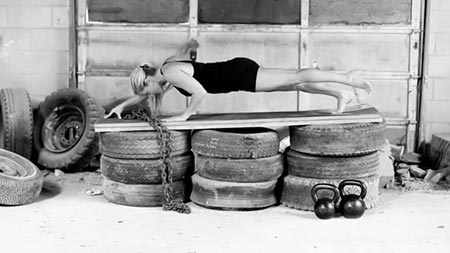
How Bodyweight Training Maintained My Press
Due to a busy travel schedule, bodyweight training constitutes the majority of my own training. I do my bodyweight skills as a practice or using a grease-the-groove approach (GTG). Many of the reps I do in my “training” are purely from doing single-rep demos while teaching. And guess what? I have stayed strong and gotten even stronger in many skills without actually having them in a training “program.”
I had a week break in my travel schedule recently and decided to test my kettlebell skills. I haven’t picked up many heavy kettlebells lately and definitely haven’t been military pressing. The last time I trained the 24kg military press was back in 2012 when preparing to do the Iron Maiden Challenge. I never doubted that my SFB skills would keep me strong, but I wanted to test how far I was from the 24kg.
I grabbed a 20kg first. It went up with ease! So, of course, I had to test the 22kg and again it went up with ease! I was very pleasantly surprised. I took a quick rest, grabbed the phone to record my technique to know what I needed to work on—and bam, the 24kg went up on both sides.
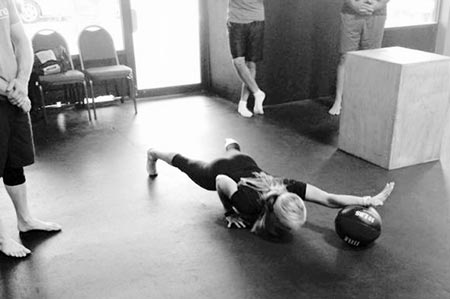
The SFB Can Help Your SFG Goal
I credit this strength to the tension and grip work required in training our SFB bodyweight skills. More than one SFB attendee has stated on their evaluation forms that had they attended the SFB prior to SFG I or II they would have done better and been stronger for their pressing due to having a greater understanding of the importance of tension, breathing, and grip.
Now, don’t freak out and think I am saying you should give up your kettlebell or barbell training. I am simply recommending you give bodyweight strength training a try. Consider either adding it to your current program by doing GTG or taking a break from your current plan and doing a four- to eight-week bodyweight-only program. In my opinion, you will learn a great deal about your body in the process.
Before You Start This Training Program
If you’re ready for a bodyweight strength experiment, below is a training program you can follow. Bodyweight training is tremendous for all ages and all fitness levels, but before you embark on this program, there are a few important details to consider.
First, it is important to know and remember that bodyweight training is a bit different from other training you have done. It may not be as physically demanding, but it is very neurologically fatiguing.
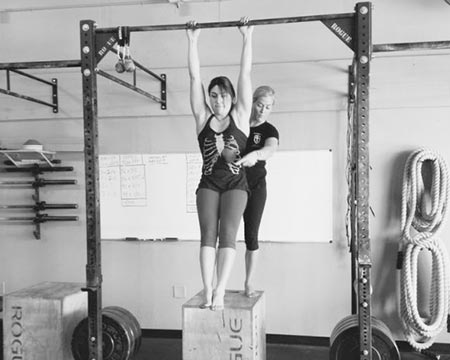
Next, remember that patience is required. Find the modifications that are appropriate for your current strength level and spend some time there. If you rush too quickly, you will set in bad habits. And, like with any training program, if movements are not done with proper technique, they can lead to injury.
So while you may look at this program and think, “This looks so easy,” remember that your nervous system can be fried quickly in the beginning. Take your time and use the required tension and technique.
Note: I highly recommend stretching your wrists, ankles, and hips before and after all bodyweight tension/strength work.
Bodyweight Training Program
| Monday
(Medium 8 RM) |
Wednesday
(Light 10RM) |
Friday
(Heavy 3-5 RM) |
| Hanging Leg Raise Lowers x 5
Rest and repeat x 3 Each rep begins at the top with a slow lower to the L position. |
Flexed Arm Hang for time
Hollow Hang for time Rest and repeat x 3 Track progress, and increase time when these become easy. |
OAPU or OAOL Pushups x 2R/L
Hanging Leg Raise x 1 Rest and repeat x 5 Each pushup will be at the level appropriate for your current strength. |
| Pistol x 5R/L
Rest and repeat x 3 Each rep you begin seated completely relaxed, then with a tension breath “ZIP UP” and stand. |
SLDL x 8R/L
OAPU/ OAOL PU x 8R/L Rest and repeat x 3 Each SLDL should be slow and controlled to gain balance and strength. If easy, close your eyes. Each pushup should be slow and controlled technique. |
Pistol Lowers x 3R/L
Pullups x 1-3 Rest and repeat x 4 Each pistol, slowly lower to appropriate level without falling through or resting on the surface. If pullups are easy, try keeping your legs in an L-sit to maintain/build core strength. |
| OAPU x 5R/L
Pullup or Chin-up x 3-5 Rest and repeat x 3 Select appropriate box height or wall for your pushup strength. If you cannot currently do pullups/chin-ups, add in flexed arm hangs until you can hold for 30-45 secs each round. |
Grip work:
Chin-ups, Alternate Grips Pullups, Towel Hangs, etc. for time. X 3 Increase the time you hold each week. Track your progress. |
Hollow Rockers x 20
OA or OAPL Plank: 15R/L Rest and repeat x 3 Increase your plank time as you get stronger. Remember it is important to not increase the time if your form is lacking (sagging, etc.). |
| Hollow Hold on the ground for time x 3
Increase your hold time over the weeks. Remember it is important to stop if your lumbar spine comes off the ground. |
Headstand hold for time x 3-5
Increase your hold time over the weeks. Your balance will increase. If you are not comfortable upside down, have someone spot you, or do your headstand with a wall behind you to catch you. |
Handstand holds for time x 3-5
Increase your hold time over the weeks. While your balance will improve, you will also be strengthening your shoulders in preparation for handstand pushups. |
I look forward to hearing your feedback once you have given this program a try! Please post any questions in the comments below.
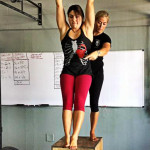
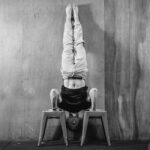
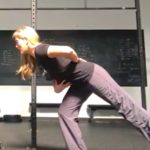
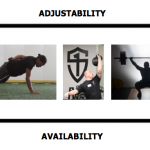


What is medium 8 RM light 10 RM ?
Hi, what is the OAPL Plank?
Thank you.
One-arm plank
oops – sorry you guys that is a typo..
OAPU is one arm push up
OAOLPU is one arm/one leg puhsup
and this should say OA or OAOL Plank
Why are there more reps for the OAPU on the medium day than the light day?
The change in elivation. So if you keep the elivation the same then do more on your medium day.
example: Medium day might be a chair height with 5/5 reps because the elevation is harder than say a desk or counter top on light day so more reps on a easier elevation.
Another way to wave the load could be:
A. Do same reps each day at different elevation
B. Do different reps each day with same elevation.
However for this program I gave you a wave in the intensity and volume.
Hope that helps
Hi Karen,
i like your article about your bodyweight training experiences and your workout example. I want to build up strength with bodyweight routines too and Í’m excited to the progress. Thanks Susann
Hi Karen, I will attend the SFB next december in Italy. I am already able to do full handstand PU, do you think I have use them on Friday? Thanks, mr
Yes – I selected the easier progression for this article but they can all be modified depending on your strength level. So if you have HSPU then you replace the handstand holds.
Hi Karen, I have a squat question. While I can get into a deep squat, my chest rounds forward and I am not able to raise my arms straight over my head from this position. This came to my attention when I was the subject of an FMS. Should I work on changing this during as I try to do a pistol squat? If so, do you have any recommendations for me? I have completed the SF Body Weight course as well as the KB Course and I’m currently working toward becoming an RYT.
So sorry for the late reply as for some reason it did not notify me of the comments.
For squat you would need to have a flat back and no rounding in your spine, so I would work to improve your tspine and shoulder mobility.
As for pistols as flat back is not required as some spine flexion is needed so you should be able to proceed with the progressions But I would still work your mobility/flexibility to improve all other areas that it is needed.
Hi Karen –
I’ve been using this workout as my template for training for the Boston cert this April/May. In regards to the OAPU – I’m still working towards lowering to the ground (especially on my left side). Regarding your recent Panche pushup video…is it best to elevate the one arm or work the panche pushup to the ground. I’ve found that to be a helpful regression. Also, I’m really starting to feel the benefits of greasing the groove. I was getting a bit discouraged, but kept pressing on and now the movement is starting to come together!
Should I match 8 RM 10 RM and 3-5 RM for my experience and progression level? For exemple on light days pull up with my bodyweight or stay at the hang?
Yes – the hang is listed for those who do not yet have a pullup, if you have pullups currently with enough volume to wave the load then do so. If not the do pullups on day, and flex hang another and even maybe weighted hangs or weighted pulls another – all dependent on your fitness level/strength
Thanks for the article. In 2004 I was struggling to press my 32 kg bell and ended up really burning myself out.
I spent four weeks following the naked warrior at a low volume… One to three sets of each exercise and never close to failure. When I returned to the kettlebells I was amazed that my ability to generate tension had improved so much. Thanks for the reminder.
I seem to have flexibility problems with the leg raises and pistols ( I can’t keep my legs straight when doing leg raises and when doing pistol squats my heel tends to raise before I even reach parallel) any suggestions/ specific stretches I should try?
I would work your ankle mobility and check the pistol article that I have published here also.
Ok quite a few questions on my part. I’m just starting this and everything is very challenging for me. I did go to a bodyweight workshop with an SFB in my area, so I did learn the proper tension techniques and regressions for the exercices. I just am not sure how to go about the light/medium/heavy considering I’m at the easiest regression on most exercises.
For pistols:
on medium day I do only concentric portion only? Start on bench zip up stand and lower on two legs and repeat?
on heavy days I do eccentric only? Then stand up on two legs (close squat)?
For OAPU: I can only do them on a wall with good tension, when I go on a table or so I can’t keep good form so I do those on heavy day, what do I do on medium and light days? One arm planks? Regular push-ups with hands together?
For pull-up/chin-up: I can only do one chin-up and that’s on a good day so do I only do flexed arm hangs? Or hollow holds on light/medium days and flexed on heavy days?
For the HLR: I can bring legs to L position and no higher. I do them on the floor with back propped up to get stronger on the 2nd half of the lift. How do I do those for light/medium/heavy?
Thanks for the help.
Pistol: light day, lower to an elevation without sitting and stand back up, over time go lower. Medium day: sit relaxed on an elevation and zip up and stand. Heavy day: use a kb and lower on two legs(feet together/knees togther) try to expend one leg at the bottom and then the other. Then stand back uo on both legs.
OAPU- light day: OAOL plank, medium day: OAPU on wall, heavy day: singles on the counter top
Pull up- light day:hollow hangs, medium day: flexed hangs, heavy day: one chin. Increase as you get stronger
HLR- light day: knee raises, medium day: raise to L, heavy day: curl up to bar and work slow negatives from the too down.
Hope that helps. There are many options to wave the load.
Great article. I will start this program this week and provide feedback as I go through it.
Thank you
Look forward to hearing your feedback.
Hey so what are the odds that S1 will release a bodyweight training plan, and expand on Naked Warrior? For ex. Naked Warrior doesn’t mention front levers though I believe it is now a part of S1.
So the SLDL are just body weight? Does S1 have a video for those? I’m picturing myself touching my toes at the bottom…? Also, it is Friday night, why am I reading articles about pull-ups. Oh well, cheers!
https://www.youtube.com/watch?v=g27sjmFEGHM
I wouldn’t worry so much about touching your toes as I would with maintaining a neutral spine and stability in the core and hips to resist rotation.
Yes the SLDL in the article is BW. The ideas is to work then slowly and maintain proper form. Neutral spine, hips level with floor and work your balance. If just too easy then try them with the eyes closed. 🙂
Thanks for posting a bodyweight program. It’s nice to see on this site. I have a question on the part with isometrics. Every time I try to just increase the hold time it works for a few weeks. Then I end up hitting a wall and my hold time DECREASES, which is not cool. Why does this happen and what can I do to stop that?
It really depends. What holds, how long, how often and what other skills are you working? As I mention in another post, BW practice requires full body tension and is more neuralogiclly fatiuging, which can quickly put you into an over training state. The is one reason it is important to wave the load and include rest days if you are working advanced BW skills.
I understand it now. I regressed on exercises when I was working on 7 skills (5 gymnastic isometrics, 2 dynamic) with two sets a day for each, each done five times a week without much waviness. For time management it was a great to do a lot of different things almost spread like GTG whenever I had a second in the morning and evening. But from your comments I can see exactly why it failed on delivering gains. Thank you for answering.
This is great. I have two questions.
1: What are OAOL push-ups?
2: I’m not sure how to understand the rep max reference next to the light, medium, and heavy references. How does that tie in?
Thanks, Karen.
James,
OAOL = one arm/one leg
Karen can chime in about the RM range, but as I understand it, for BW work, it is chosing those leverages/movements for an adjustment to intensity based on your current strength in a particular movement.
Great article Karen! BW work is very underappreciated, and you do a fantastic job communicating, teaching, and deconstructing this material.
Got it. Thanks, Al.
Hello –
Yes, Al was correct in that the RM helps you to determine the elevation or progression for a light/medium/heavy day. This allows for great strength gains and helps dial in technique vs going to the MaX each session.
Great article, coach Karen!
A brilliant illustration to the principle of the interchangeability of training implements. Bodyweight powerlifts can not only successfully substitute weights for some period of time, but build a decent level of strength by itself, moreover, increased body awareness is always a good bonus.
I want to drop kettlebells for a month or a month and a half. Thus, I was wondering, how to modify the template according to one’s training level (doing HSPU instead of HS hold, archer or assisted OA pull-up instead of regular ones and so on) and what about mixing in some conditioning work, maybe burpees, sprints or bodyweight basics circuits on the days free from strength training or on the top of those (a month without working lungs and heart seems to long)?
Thank you in advance.
You can adapt it to account for your RM for light/medium/heavy days. If you can do 10 archer pull ups do them on the light day. If your RM is 3-5 do them on the heavy day.
Thanks for the response, Nick. This morning I got started with the program.
May I ask you and other athletes about how to include conditioning work into this template?
Running, hiking, swimming, cycling, jumping rope, swinging kettlebells…the list goes on. Burpees and bodyweight circuits are in the same general area as the program. For conditioning get outside and do something different.
As for adding in your conditioning, there are many options. I would recommend you do them at the end of your sessions as a finisher and keep your rest days, rest days. BW takes more tension and neural drive which can be very fatiging so rest days are important especially the more advanced the skills.
What is a body weight SL DL. Is it different than doing it with kettlebells so it is more challenging?
SLDL = single leg dead lift
Fantastic piece Coach Karen – thank you. Please bring the SFB Bodyweight Instructor Certification to Australia! I’ll be there 100% when SF does so.
Thank you!
I am sure we will be back to Australia in 2017 for SFB.